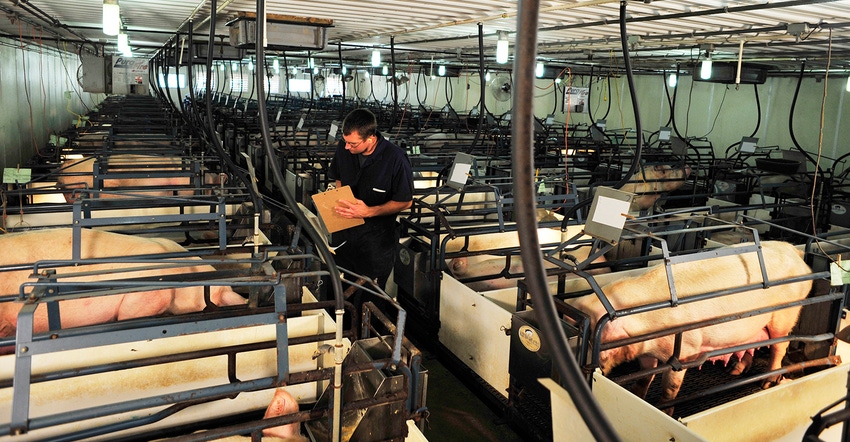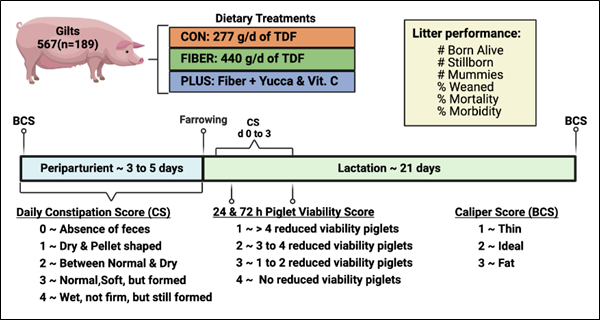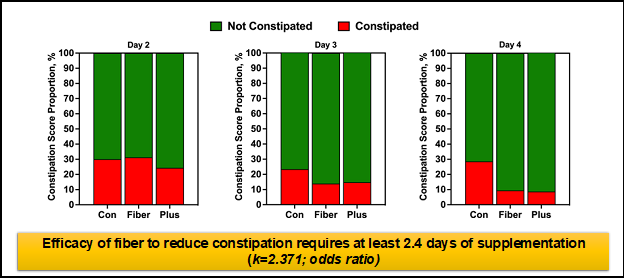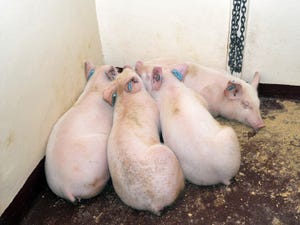Increasing TDF decreases gilt constipation, improves preweaning mortality
Fiber supplementation during the transition period is a strategy gaining attention to support metabolic changes.
April 10, 2024

By Erick Fuentes, Rachel Self and Amy Petry, University of Missouri; Pete Wilcock and Spenser Becker, Ab Vista
During the transition period—spanning approximately from seven to 10 days pre-parturition to three to five days post—sows undergo substantial physiological and metabolic changes (Theil et al., 2022). The productivity of sows is heavily reliant on this critical period, marked by a high rate of piglet mortality either during parturition or in the days immediately following. The survival and growth of piglets are also influenced by mammary development, fetal growth, sow health and colostrum production during this period.
Additionally, one common challenge pre-farrow, particularly for gilts, is constipation, which can lead to discomfort, reduced feed intake and compromised farrowing performance. Fiber supplementation during the transition period is a strategy gaining attention to support metabolic changes during the transition period such as improving the energy status of the sow through farrowing leading to improved sow health, reduced stillborns as well as alleviate constipation.
Dietary fiber, in the context of swine nutrition, can be defined as all plant polysaccharides and lignin that are resistant to hydrolysis by endogenous secretions of the gastrointestinal tract. In gestating sows, the benefits of DF on satiety, welfare and behavior have been well established, and work in Europe has shown DF supplementation in the transition period reduces stillborn rates and improves constipation (Oliviero et al., 2010; Feyera et al., 2017).
Likewise, previous studies have shown that saponins from yucca and vitamin C alter the antioxidant status of gilts and improve the efficiency of the litter, reducing stillborn and preweaning mortality (Herpin et al., 2014; Knauer et al, 2023). Thus, our experimental objective was to evaluate fiber supplementation including a stimbiotic to stimulate fiber fermentation and its combination with yucca and vitamin C during the periparturient period of gilts on constipation status, body condition score and farrowing performance.
A total of 567 gilts were allotted according to a randomized complete block design distributed across six farrowing rooms to 1 of 3 dietary treatments (n=189/treatment). A subset of focal gilts from one farrowing room (n=32/treatment) were selected for sample collection and litter weights. Dietary treatments included a control top dress targeting a daily intake of 277 g of total dietary fiber using ground corn; a top dress consisting of wheat midds, beet pulp, soy hulls, rice hulls, ground corn, and a stimbiotic targeting 440 g of TDF per d with 70 g of soluble fiber; and FIB treatment with 680 mg of vitamin C and 2.5g of yucca. A total of 454 g of the respective top dress was provided on top of the lactation diet for a minimum of 3 days pre-farrow and throughout the lactation period (Figure 1).

Figure 1: Overview of experimental design.
Litter performance data was collected throughout the experimental period. A daily constipation score was assessed using a five-point scale from study initiation until three days post farrowing: 0= absence of feces, 1= dry and pellet shaped, 2= between normal and dry, 3=normal, soft, but formed, and 4= wet, not firm. Litter viability was also evaluated at 24- and 72-h post-farrowing using a predefined scale.
Overall, supplementing gilts with fiber either as FIB or PLUS decreased incidences of constipation by 21% prior to farrowing (Figure 2).

Figure 2: Incidences of constipation were decreased by fiber supplementation during the periparturient period.
This resulted as fiber supplementation transitioned gilts from severe constipation state to a score of normal defecation frequency. Interestingly, for this response to occur, fiber supplementation needed to be provided for at least 3 days pre-farrow (Figure 3).

Figure 3: Fiber supplementation required 2.4 days of supplementation to reduce constipation in gilts.
This is not surprising as rate of passage in sows is slowed down in late gestating sows, and with reduced activity during this state, defecation rate is already reduced. When constipation was evaluated post farrowing, the benefits of fiber on constipation remained, and reduced incidences of constipation by 38% (Figure 4).

Figure 4: Constipation continued to decrease post-farrow with fiber supplementation.
The influence of fiber on constipation observed in this study can be partially attributed to the physicochemical properties of DF affecting the interplay of water with digesta dry matter in the hindgut and subsequently, gut motility. These properties include bulk density, viscosity, cation-binding, water holding capacity, water binding capacity, water retention and water swelling (Navarro et al., 2019). This is important as alterations in gastrointestinal motility can increase constipation incidences and colonic impactions in late gestation can act as a barrier to the birth canal, resulting in dystocia (Moturi et al., 2022). Intriguingly, within this same study supplementing DF tended to reduce stillborns and decreased pre-weaning mortality by 16% (Figure 5).

Figure 5: Fiber supplementations decreased preweaning mortality and reduced stillborn rate.
In conclusion, providing an extra 150 g of DF throughout the periparturient period lowered the occurrence of constipation, decreased stillborn rates, and reduce preweaning mortality in this study. Vitamin C and Yucca supplementation did not yield any additional benefits. Collectively, these findings highlight that increasing TDF during the periparturient and lactation period may aid in alleviating constipation and improving litter performance.
Appreciation is expressed to Iowa Select Farm and Sow Farm 39 staff for supporting this project within their system.
Citations:
Agyekum, A.K. and Nyachoti, C.M., 2017. Nutritional and metabolic consequences of feeding high-fiber diets to swine: a review. Engineering, 3(5), pp.716-725.
Feyera, T., Højgaard, C.K., Vinther, J., Bruun, T.S. and Theil, P.K., 2017. Dietary supplement rich in fiber fed to late gestating sows during transition reduces rate of stillborn piglets. Journal of Animal Science, 95(12), pp.5430-5438.
Herpin, P., Vincent, A. and C. P. 2004. Effect of feeding Yucca schidigera (DK powder) to the sow on piglet blood oxygenation and survival. Proc West Sect Amer Soc Anim Sci. 55.
Knauer, M., 2023. PSIV-2 Impact of Vitamins C and E on Sow Mortality and Stillborn Rate. Journal of Animal Science, 101(Supplement_2), pp.352-353.
Moturi, J., Hosseindoust, A., Tajudeen, H., Mun, J.Y., Ha, S.H. and Kim, J.S. (2022). Influence of dietary fiber intake and soluble to insoluble fiber ratio on reproductive performance of sows during late gestation under hot climatic conditions. Scientific Reports12(1),19749
Navarro, D.M.D.L., Bruininx, E.M.A.M., De Jong, L. and Stein, H.H. (2018). The contribution of digestible and metabolizable energy from high-fiber dietary ingredients is not affected by inclusion rate in mixed diets fed to growing pigs. Journal of animal science96(5),1860-1868.
Oliviero, C., Heinonen, M., Valros, A. and Peltoniemi, O., 2010. Environmental and sow-related factors affecting the duration of farrowing. Animal reproduction science, 119(1-2), pp.85-91
Theil, P.K., Farmer, C. and Feyera, T., 2022. Physiology and nutrition of late gestating and transition sows. Journal of Animal Science, 100(6), p.skac176.
You May Also Like



